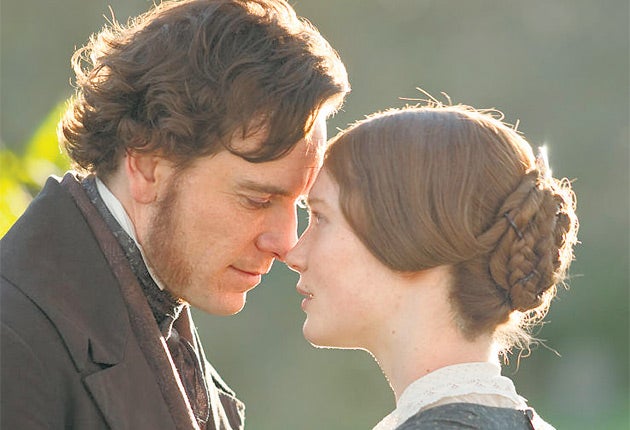Jane Eyre - Reader, she's marrying him again
She's 18, he's old enough to be her dad, but film-makers still fixate on the love story of Jane Eyre and Rochester. Gerard Gilbert explores a long-held romantic obsession

Your support helps us to tell the story
From reproductive rights to climate change to Big Tech, The Independent is on the ground when the story is developing. Whether it's investigating the financials of Elon Musk's pro-Trump PAC or producing our latest documentary, 'The A Word', which shines a light on the American women fighting for reproductive rights, we know how important it is to parse out the facts from the messaging.
At such a critical moment in US history, we need reporters on the ground. Your donation allows us to keep sending journalists to speak to both sides of the story.
The Independent is trusted by Americans across the entire political spectrum. And unlike many other quality news outlets, we choose not to lock Americans out of our reporting and analysis with paywalls. We believe quality journalism should be available to everyone, paid for by those who can afford it.
Your support makes all the difference.It is surely the most famous riding accident in literature – and on screen, given the number of times Charlotte Brontë's Jane Eyre has been translated into film or television drama. It is dusk, dear reader, and Jane, a governess, is on an errand to post a letter from Mr Rochester's residence, Thornfield Hall, when Rochester's passing horse skids on the ice and un-seats Jane's future inamorato. This is the first time she has clapped eyes on her employer – not that she as yet knows his true identity.
"His figure was enveloped in a riding cloak, fur collared and steel clasped," Brontë has her heroine observe. "I traced the general points of middle height and considerable breadth of chest. He had a dark face, with stern features and a heavy brow... he was past youth, but had not reached middle-age; perhaps he might be 35."
Not exactly love's young dream, then. In fact, his age apart, Brontë might be describing Gordon Brown. Jane is 18, and the age difference with Rochester has rarely been adhered to in the screen adaptations of Brontë's smouldering Gothic melodrama. Perhaps such an age gap has been considered indecent, although it was deemed unremarkable in Hollywood movies for leading men, from Cary Grant to Harrison Ford, to squire screen actresses at least half their age.
The 1970 TV-movie version, with a 31-year-old Susannah York and a 43-year-old George C Scott, is one of the few of the 25-plus film and television versions of Jane Eyre to have a plainly – almost shockingly – visible age gap. And although there is an identical age difference between the leads in the new Jane Eyre movie, Mia Wasikowska (23) and Michael Fassbender (35), it is somehow less noticeable. Thirty five is obviously the new 25.
Orson Welles, cinema's most famous Mr Rochester, was only two years older than his co-star Joan Fontaine in the 1943 Hollywood adaptation. If he seems considerably older, it's because he gives a performance of cocksure experience, while Fontaine had honed her maidenly timidity four years earlier as the heroine-victim in Alfred Hitchcock's film of Daphne du Maurier's Rebecca. The similarity between Rebecca and Jane Eyre has oft been noted, so the casting of Fontaine in both roles has a pleasing logic to it.
Welles's barn-storming Rochester apart, this Jane Eyre was dismissed as "operatic" and "empty" by some critics. It might not even have been the best version of Jane Eyre to be made during the Second World War. That accolade might go to I Walked with a Zombie, which transplanted Brontë's romance to a voodoo-ridden West Indies, 70 years before the undead will infiltrate Jane Austen in the upcoming film of Seth Grahame-Smith's novel Pride and Prejudice and Zombies.
But back to the un-zombified screen renditions of Jane Eyre. There were seven silent films made of Brontë's 1849 novel, including Orphan of Lowood. The first sound version was filmed in 1934, starring Colin Clive, in supremely dodgy sideburns, and Virginia Bruce, whose expressive, kohl-rimmed eyes were made for the silent era. This Jane Eyre might have been better off remaining silent: the tinny dialogue comes across more like a drawing-room comedy than a Gothic romance.
The real rush of Jane Eyre adaptations had to wait for the television age, Brontë's story being well-suited to the expansiveness of a TV series. There were five American versions in the early Fifties (including one with Charlton Heston as Rochester) before the first British serialisation, in 1956, with Stanley Baker – then typecast as the boorish heavy – as Rochester. British TV next serialised Jane Eyre in 1963, with the character actor Richard Leech – an intimidating presence, he played Mr Murdstone in the BBC's 1966 version of David Copperfield – in the role.
Since then, TV has revisited Jane Eyre every 10 years or so: in 1973 with Sorcha Cusack and Michael Jayston; in 1983, starring a pre-007 Timothy Dalton and Zelah Clark; and in 1997, with Samantha Morton and Ciará* Hinds. The most recent cinema version was Franco Zeffirelli's 1996 film starring Charlotte Gainsbourg as the adult Jane (Anna Paquin, Sookie in HBO's True Blood, played the younger version) and William Hurt as Rochester. Dalton had the dark Byronic looks, Hinds the masterful mien, Hurt seemed wistful, haunted and miscast. Toby Stephens seemed merely miscast in the most recent TV version, from 2006.

Watch Apple TV+ free for 7 days
New subscribers only. £8.99/mo. after free trial. Plan auto-renews until cancelled

Watch Apple TV+ free for 7 days
New subscribers only. £8.99/mo. after free trial. Plan auto-renews until cancelled
If Rochester should be dark and brooding, verging on cruel, what of Jane? Is she a plain Jane, or is she more jolie laide – unconventionally beautiful actresses certainly being favoured by the directors who cast Ruth Wilson and Charlotte Gainsbourg. Mia Wasikowska, ethereal in her own skin (as she proved in Tim Burton's Alice in Wonderland), has been scrubbed back as the latest Jane on the block, making her fit Rochester's description of his governess: "you are not pretty any more than I am handsome."
But it is Jane's moral dignity and spirited intelligence, not her appearance, that attracts Rochester, and what is perhaps surprising is the absence of an overtly feminist adaptation. After all, this is the literary heroine who observes that, "Women feel just as men feel; they need exercise for their faculties, and a field for their effort, as much as their brothers do... it is too narrow-minded to say that they ought to confine themselves to making puddings and knitting stockings, to the playing of the piano and embroidered bags."
Cary Fukunaga, director of the new adaptation, sees Jane in a traditional light, as balm for Rochester's tortured soul. "(He is) a Byronic hero, somebody who is carrying the past with him," he says. "I had this feeling that he had been to some very decadent places in his life, and his guilt and bitterness and his lost youth is there in flashes. It's through Jane that he becomes healed."
One day Wasikowska and Fassbender's post-feminist Jane Eyre and Mr Rochester will seem as dated as Welles and Fontaine's pre-feminist versions, but that is surely the attraction to successive generations of artists, delighted to revisit these archetypal lovers afresh. Just as long as Cliff Richard, having made a musical out of Wuthering Heights' Heathcliff, doesn't turn his attention to another Brontë-sister Gothic hero. After all, Jane Eyre has already inspired three musicals to date, not to mention two operas, two ballets and an orchestral symphony. We are unlikely to have seen the last of these lovers just yet.
Eyres and graces: the finest on-screen pairings
Orson Welles and Joan Fontaine (1943)
With a screenplay co-authored by Aldous Huxley, a Bernard Herrmann score and an uncredited Elizabeth Taylor in support – the most famous movie version recreated the Yorkshire moors on a Hollywood sound stage. Joan Fontaine's damsel-in-distress Jane won't impress feminist fans of the novel.
Susannah York and George C Scott (1970)
At the age of 31, Susannah York (right) was too old to play Jane, although she seemed young next to the 43-year-old George C Scott's prematurely middle-aged Rochester. Perhaps his Oscar-winning performance as General Patton had taken it out of the actor. Lovely landscapes but a turgid pace and a fatal lack of atmosphere.
Michael Jayston and Sorcha Cusack (1973)
A little-known but highly regarded BBC mini-series, with a distinctly un-Byronic Michael Jayston surprisingly good as a complex Rochester. More faithful to the text than most, with large chunks lifted from the book, which would make it a useful aid to GCSE students.
William Hurt and Charlotte Gainsbourg (1997)
Noting a lack of sexual chemistry between the leads in Franco Zeffirelli's handsome cinema version, one critic described William Hurt's Mr Rochester as "so amiable he's practically a New Man: pleasant enough as a companion, though probably not very good in bed". Ouch. Maria Schneider, of 'Last Tango in Paris' fame, plays the mad woman in the attic.
Toby Stephens and Ruth Wilson (2006)
TV's most recent foray into Charlotte Brontë's Gothic novel produced differing reactions to the leads. Ruth Wilson (most recently seen stealing 'Luther' from under Idris Elba's nose) gave a breakthrough performance, while Toby Stephens's Rochester was described by one critic as "more ironic than Byronic".
Join our commenting forum
Join thought-provoking conversations, follow other Independent readers and see their replies
Comments